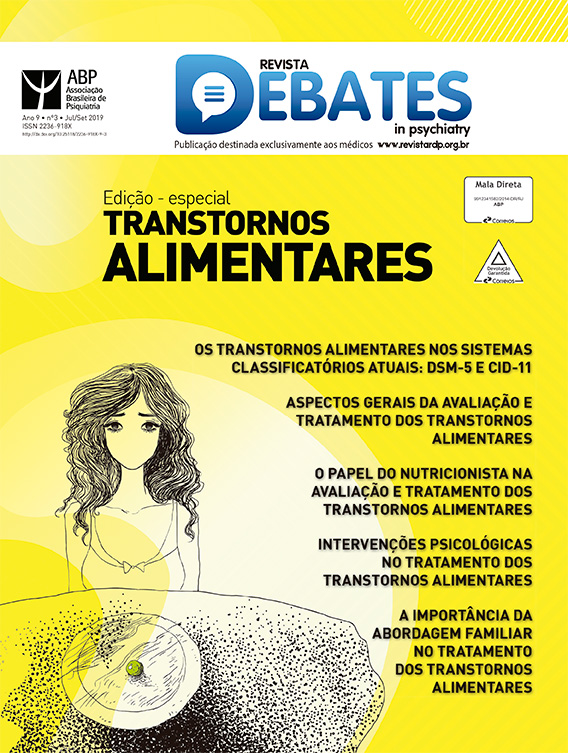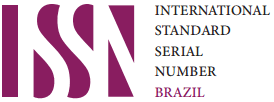Aspectos gerais da avaliação e tratamento dos transtornos alimentares
DOI:
https://doi.org/10.25118/2763-9037.2019.v9.50Palavras-chave:
Tratamento, anorexia nervosa, avaliação, transtornos alimentaresResumo
Os transtornos alimentares são quadros psiquiátricos que cursam com intenso sofrimento psíquico e diversas complicações clínicas. A avaliação de pacientes com transtornos alimentares costuma exigir uma anamnese minuciosa, exame físico e psíquico detalhado e exames complementares. Nessa avaliação, objetiva-se estabelecer um diagnóstico nosológico do transtorno alimentar e das comorbidades, uma estratificação do risco clínico e psiquiátrico, para então estabelecer um planejamento terapêutico. Após essa avaliação inicial, de acordo com a gravidade do caso, o clínico deve decidir o nível de tratamento recomendado, que pode ser desde a hospitalização até o atendimento ambulatorial regular. Outras decisões, como a via de realimentação, o valor calórico planejado para a realimentação e as metas de recuperação, também devem ser pré-definidas. Sumarizamos, neste artigo, alguns aspectos relacionados à avaliação, comorbidades e orientações gerais de tratamento a partir de três diretrizes internacionais de manejo e tratamento de transtornos alimentares, a saber: duas britânicas, a guideline de transtornos alimentares do National Institute for Health and Care Excellence (NICE) e o Management of Really Sick Patients with Anorexia Nervosa (MARSIPAN); e uma australiana, elaborada pelo Royal Australian and New Zealand College of Psychiatrists (RANZ-CP).
Downloads
Métricas
Referências
Appolinario JC, Freitas S, Nazar BP; Programa de Atualização em Psiquiatria (PROPSIQ). Transtornos alimentares. In: Nardi AE, Silva AG, Quevedo JL, organizadores. Transtornos alimentares. 4ª ed. Porto Alegre: Artmed Panamericana; 2015. p. 43-93.
Associação Americana de Psiquiatria. Manual Diagnóstico e Estatístico de Transtornos Mentais, 5ª edição (DSM-5). Porto Alegre: Artmed; 2014.
Halmi KA. Salient components of a comprehensive service for eating disorders. World Psychiatry. 2009;8:150-5.
National Institute for Health and Care Excellence (NICE). Eating disorders: recognition and treatment [Internet]. NG69. 2017 May [cited 2020 Jan 14]. www.nice.org.uk/guidance/ng69
Hay P, Chinn D, Forbes D, Madden S, Newton R, Sugenor L, et al. Royal Australian and New Zealand college of psychiatrists clinical practice guidelines for the treatment of eating disorders. Aust N Z J Psychiatry. 2014;48:977-1008.
Hilbert A, Hoek HW, Schmidt R. Evidencebased clinical guidelines for eating disorders: international comparison. Curr Opin Psychiatry. 2017;30:423-37.
Allison E, Dawson N, Phillips J, Lynch C, Coleman J. Fifteen minute consultation: a structured approach to the management of children and adolescents with medically unstable anorexia nervosa. Arch Dis Child Educ Pract Ed. 2017;102:175-81.
Gibson D, Workman C, Mehler PS. Medical complications of anorexia nervosa and bulimia nervosa. Psychiatr Clin North Am. 2019;42:263-74.
Brown C, Mehler PS. Medical complications of anorexia nervosa and their treatments: an update on some critical aspects. Eat Weight Disord. 2015;20:419-25.
Quintana ABM, Assumpção CRL. Diagnóstico e manejo das condições clínicas associadas aos transtornos alimentares. In: Nunes MA, Appolinario JC, Galvão AL, Coutinho W, et al., editores. Transtornos alimentares e obesidade. 2ª ed. Porto Alegre: Artmed; 2006. p. 195-206.
Fazeli PK, Klibanski A. Effects of anorexia nervosa on bone metabolism. Endocr Rev. 2018;39:895-910.
Royal College of Psychiatrists. MARSIPAN: Management of really sick patients with anorexia nervosa [Internet]. 2nd ed. 2014 Oct [cited 2020 Jan 15]. www.rcpsych.ac.uk/docs/default-source/improving-care/better-mhpolicy/college-reports/college-report-cr189.pdf?sfvrsn=6c2e7ada_2
Mehler PS, O’Melia A, Brown C, Gibson D, Hollis J, Westmoreland P. Medical complications of bulimia nervosa. Br J Hosp Med (Lond). 2017;78:672-7.
Royal College of Psychiatrists. Junior MARSIPAN: management of really sick patients under 18 with anorexia nervosa [Internet]. Report CR168. 2012 Jan [cited 2020 Jan 15]. www.rcpsych.ac.uk/docs/default-source/improving-care/better-mhpolicy/college-reports/college-report-cr168.pdf?sfvrsn=e38d0c3b_2
Resmark G, Herpertz S, Herpertz-Dahlmann B, Zeeck A. Treatment of anorexia nervosa—new evidence-based guidelines. J Clin Med. Jan 29;8(2). pii: E153. doi: 10.3390/jcm8020153.
Falcão MA, Francisco R. Diabetes, eating disorders and body image in young adults: an exploratory study about “diabulimia”. Eat Weight Disord. 2017;22:675-82.
Garber AK, Sawyer SM, Golden NH, Guarda AS, Katzman DK, Kohn MR, et al. A systematic review of approaches to refeeding in patients with anorexia nervosa. Int J Eat Disord. 2016;49:293-310.
Rizzo SM, Douglas JW, Lawrence JC. Enteral nutrition via nasogastric tube for refeeding patients with anorexia nervosa: a systematic review. Nutr Clin Pract. 2019;34:359-70.
Friedli N, Stanga Z, Sobotka L, Culkin A, Kondrup J, Laviano A, et al. Revisiting the refeeding syndrome: results of a systematic review. Nutrition. 2017;35:151-60.
Bargiacchi A, Clarke J, Paulsen A, Leger J. Refeeding in anorexia nervosa. Eur J Pediatr. 2019;178:413-22.
Marvanova M, Gramith K. Role of anti depressants in the treatment of adults with anorexia nervosa. Ment Health Clin. 2018;8:127-37.
Hilbert A, Hoek HW, Schmidt R. Evidencebased clinical guidelines for eati ng disorders: internati onal comparison. Curr Opin Psychiatry. 2017;30:423-37.
Atti a E, Steinglass JE, Walsh BT, Wang Y, Wu P, Schreyer C, et al. Olanzapine versus placebo in adult outpati ents with anorexia nervosa: a randomized clinical trial. Am J Psychiatry. 2019;176:449-56.
Zipfel S, Giel KE, Bulik CM, Hay P, Schmidt U. Anorexia nervosa: aeti ology, assessment, and treatment. Lancet Psychiatry. 2015;2:1099-111.
American Psychiatric Associati on (APA). Practi ce guideline for the treatment of pati ents with eati ng disorders. 3rd editi on. American Psychiatric Associati on. 2006 Jun [cited 2020 Jan 15]. psychiatryonline.org/pb/assets/raw/sitewide/practice_guidelines/guidelines/eatingdisorders.pdf
Fairburn CG, Cooper Z, Doll HA, O’Connor ME, Bohn K, Hawker DM, et al. Transdiagnosti c cogniti ve-behavioral therapy for pati ents with eati ng disorders: a two-site trial with 60-week follow-up. Am J Psychiatry. 2009;166:311-9.
Himmerich H, Treasure J. Psychopharmacological advances in eati ng disorders. Expert Rev Clin Pharmacol. 2018;11:95-108.
Hudson JI, McElroy SL, Ferreira-Cornwell MC, Radewonuk J, Gasior M. Effi cacy of lisdexamfetamine in adults with moderate to severe binge-eati ng disorder: a randomized clinical trial. JAMA Psychiatry. 2017;74:903-10.
Appolinario JC, Nardi AE, McElroy SL. Investi gati onal drugs for the treatment of binge eati ng disorder (BED): an update. Expert Opin Investi g Drugs. 2019;28:1081-94.
Downloads
Publicado
Como Citar
Edição
Seção
Licença

Este trabalho está licenciado sob uma licença Creative Commons Attribution-NonCommercial 4.0 International License.
Debates em Psiquiatria permite que o (s) autor (es) mantenha(m) seus direitos autorais sem restrições. Atribuição-NãoComercial 4.0 Internacional (CC BY-NC 4.0) - Debates em Psiquiatria é regida pela licença CC-BY-NC
































